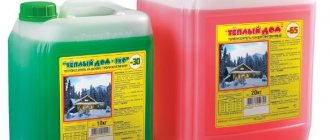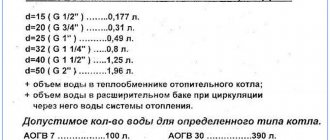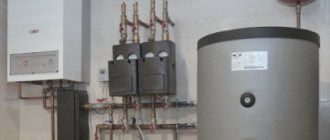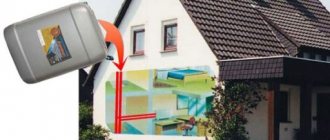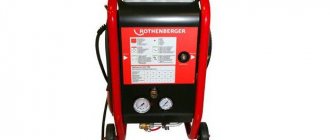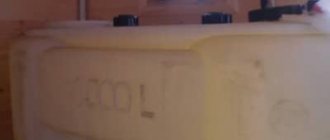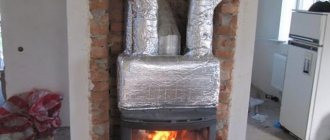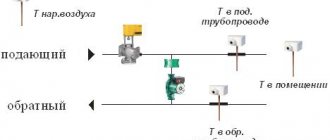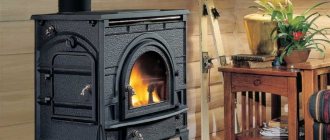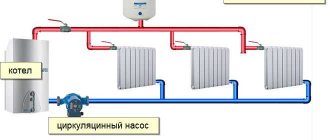The biggest danger that can threaten an individual heating system is freezing during the winter when there is a power outage. To avoid such situations, many use antifreeze for the heating system of a country house, protecting the boiler and heating pipes from deformation.
The construction market offers various brands of antifreeze for heating systems, the composition of automotive antifreeze liquids is similar, the most famous of which is Antifreeze. Therefore, many homeowners have a reasonable question: is it possible to use Antifreeze as an antifreeze for the heating circuit of an individual home and is it profitable from a financial point of view?
To get answers to this question, you should consider the physicochemical characteristics of Antifreeze and compare it with special liquids designed to protect the heating system from freezing.
Rice. 1 Antifreeze for the heating system of a country house - popular brands Teply Dom, Dixis, Thermagent
Water or antifreeze - comparison of parameters
Water is a common natural element, widely used as a heat carrier, but due to its too high freezing point, it has to be replaced in domestic heating with glycol antifreeze, which have the following indicators in comparison with water:
- Their specific thermal capacity is 15% lower than that of water, which means that with the same volume, glycol accumulates 15% less energy when heated and, accordingly, releases less. Consequently, to transport the same amount of heat as water per unit time, its speed of movement through the pipeline must be greater by the same amount.
- The density of antifreeze is slightly higher (by 5 - 10%) than water, and the viscosity is 30 - 50% higher than water indicators - this means that when the liquid moves through the pipeline, the hydraulic resistance increases. Compared with water coolant, the circulation pump will require more power and, accordingly, electricity consumption to move the same volume of antifreeze as water.
- Their thermal expansion coefficient is 30 - 40% greater than water; when heated, the glycol coolant increases in volume by 5%, the expansion is insignificant, but sometimes a slightly larger hydraulic tank may be needed.
- Due to their low surface tension, they are 50% more fluid than water - this places increased demands on sealing. Conventional rubber gaskets will have to be replaced with paronite gaskets; it often happens that the internal gaskets of heating radiators are not designed to work with glycols and measures will have to be taken to eliminate leaks between sections (modern radiators usually do not have such problems).
Rice. 2 Properties of antifreeze compared to water
- A significant drawback of relatively cheap antifreezes based on ethylene glycol is a high danger to human health; the substance is poisonous with a lethal concentration of 2 mg. per 1 kg. weight. Therefore, ethylene glycol is prohibited from being poured into systems with an open storage tank in the attic; the circuit must be closed.
- They have a short service life, designed for 10 seasons and amounting to no more than 5 years, this is due to the decomposition of anti-corrosion additives during operation. After this, you will have to drain the antifreeze from the system, dispose of it (with poisonous ethylene glycol this is a definite problem) and pour new coolant into the circuit - this will entail unjustified financial expenses.
- Unlike neutral water, low-quality or expired glycols decompose over a certain period, forming solid sediment that clogs fittings and destroys pipeline fittings.
- Another significant drawback of non-freezing coolants is the relatively high cost: a 20-liter canister of ethylene glycol with crystallization at -30º C will cost 15 USD, the price of the same volume of propylene glycol will be 30 USD.
- It should also be noted that during operation, antifreezes are very sensitive to critical temperatures - when overheated, the glycols and additives included in their composition decompose with the formation of solid insoluble precipitates and acids. This leads to the appearance of carbon deposits on the heating elements of the boiler that come into contact with the coolant; the metals are subject to destructive corrosion, and the sealing elements also suffer. The process is accompanied by increased foaming, leading to airing of the system and disruption of its functioning.
- They have restrictions in their use; their use in electrolysis boilers and pipelines made of galvanized steel is prohibited - the metal is subject to increased corrosion with the formation of an insoluble precipitate of white flakes.
Rice. 3 Features of glycol-based coolants and their cost
- A significant disadvantage of using antifreeze is the refusal of many heating boiler manufacturers to provide warranty service if glycols are poured into the system.
- The only and main advantage of antifreeze in comparison with water is the low freezing point, reaching up to -70º C. Even when a higher-temperature composition freezes (it is obtained after dilution with water in a certain concentration), the substance turns into a jelly-like mass with minimal expansion. Therefore, if you pour antifreeze into the heating system, the integrity of the pipes and boiler is guaranteed at any natural negative freezing temperatures of the circuit.
From the above, it becomes clear that water as a coolant is significantly superior to all antifreezes in its physical and chemical parameters, with the exception of its 10% expansion upon freezing, which led to the search for alternative options.
Rice. 4 Antifreeze in the heating system of a private house - instructions
Types and features of antifreeze
The heating system uses a special antifreeze that is safe for rubber parts and metal.
Antifreeze is classified according to the type of base:
- propylene glycol;
- ethylene glycol;
- solutions based on alcohol and glycerin.
The varieties differ from each other in physical and technical characteristics. When choosing one of them, you should take into account the features of the heating system and the conditions in which it operates. Special compounds are produced to fill the systems. Automotive antifreezes, such as antifreeze, are not suitable for heating. They contain a lot of toxic substances and negatively affect the rubber and metal elements of the highway; they last 1, maximum 2 years.
Propylene glycol
The main positive property of the propylene glycol composition is harmlessness. It is non-toxic and can be used in open heating systems and double-circuit boilers where water is heated for water supply. Even if propylene glycol leaks into water, significant harm to health will not occur.
Antifreeze based on propylene glycol is not toxic and decomposes faster in the environment
The technical properties of propylene glycol antifreeze are also good. They do not have an aggressive effect on the inner surface of the system elements.
There are also disadvantages:
- high viscosity, which is twice the viscosity of ethylene glycol;
- interaction with zinc: a reaction occurs with the formation of white insoluble flakes, the metal is destroyed;
- high price.
It is easy to distinguish propylene glycol coolant from ethylene glycol: the first is colored green and is often labeled ECO. Instead of propylene glycol antifreeze, you can purchase counterfeit glycerin.
Ethylene glycol
After use, ethylene glycol must be disposed of in a special way, since the substance is toxic.
Ethylene glycol compounds are highly toxic. This is their main drawback. The danger of ethylene glycol is indicated by the red or yellow color of the liquid. Thanks to the bright color, it is easier to detect coolant leaks. It may be harmful if it comes into contact with the lungs or skin. The lethal concentration when ingested is 2 mg per 1 kg of weight. In this regard, the disposal of this type of antifreeze poses a certain problem. For safety reasons, ethylene glycol coolant is used only in single-circuit systems where there is no risk of it entering the water supply circuit. The technical properties of ethylene glycol allow the use of liquids based on it at temperatures down to –65°C.
In some countries, ethylene glycol coolant is prohibited for use.
Solutions based on alcohol and glycerin
Glycerin compounds are diluted with alcohol to eliminate viscosity.
There is a mixed opinion regarding glycerin coolants. Some say that glycerin is the best household antifreeze for the heating system, others point out its many disadvantages:
- high viscosity of the substance, which accelerates equipment wear - to compensate for the high viscosity of glycerin, the composition is diluted with alcohol;
- higher density compared to other antifreezes;
- transformation into poison at temperatures above 90°C;
- risk of foaming;
- relatively low heat capacity;
- chemical interaction with rubber and plastic;
- after the water evaporates it becomes hard or jelly-like.
However, glycerin coolants have many positive properties:
- fire and explosion safety;
- environmental friendliness;
- chemical inertness to zinc;
- wide range of operating temperatures: from –30°C to 105°C;
- low cost;
- long service life - 10 years;
- do not expand when frozen.
Glycerin compositions are produced according to specifications, and this is another drawback, because manufacturers themselves set the standards.
Glycerin antifreeze is not produced in some countries.
You can also use solutions containing 40-55% ethyl alcohol as a coolant. They are environmentally friendly and crystallize at –30°C. However, their use is limited to hermetically sealed systems because they are highly volatile. The boiling point is 90°C, which is the minimum among all types of coolants.
Antifreeze for the heating system of a country house - properties and types
The construction market offers two main brands of antifreeze for heating systems in private homes: ethylene glycol and propylene glycol. Typically, in anti-freeze products the main component is glycol (30 - 65% depending on the concentration of the solution), deionized water occupies 30 - 50% of the total volume and there are 3 - 4% additives consisting of corrosion inhibitors, scale and sediment solvents, substances that prevent foaming.
Due to its composition, from the beginning of crystallization to the transformation of the non-freezing composition into gel-like slush, an interval of 10 - 15º C is required, the temperature inside of which changes gradually and takes a long time.
Manufacturers supply antifreeze packaged in 10-liter or 20-liter canisters to the retail chain in the following concentrations:
- Concentrate with crystallization at -65º C, which can be diluted with water to obtain the required freezing point.
- A solution that freezes at -30º C; it is used both in finished form and diluted to obtain higher temperature parameters from -20 to -15º C.
It is important for the consumer to know that when diluting the concentrate with water, there is no linear dependence on its percentage (graph in Fig. 8). For example, if we dilute 20 liters of a 65% concentrate with crystallization at -65º C with the same amount of water, then we will get 40 liters of liquid with a crystallization point of about - 20º C, and not - 32.5º C, as happens, for example, when diluting alcohol Therefore, to obtain the required temperature, tables of lower limits of the temperature dependence of glycols on their concentration are used (Fig. 9).
Types of antifreeze for heating
Depending on the substance that forms the base, there are three types of antifreeze:
- ethylene glycol;
- propylene glycol;
- glycerin.
Ethylene glycol products
The main disadvantage of these substances is their high toxicity when inhaled or in contact with the skin. Because of this, they cannot be used in double-circuit networks, when the coolant can enter the hot water circuit. To reduce the risk and warn the buyer of the high level of danger, such products are colored red . This allows leaks to be detected early. Antifreezes based on ethylene glycol work at temperatures down to -65 ° C.
Reference! In some developed countries, the production of anti-freeze products based on ethylene glycol is prohibited.
Ethylene glycol antifreeze is colored red to detect toxic leakage.
Prices for ethylene glycol antifreeze
Antifreeze for heating system BOILER
Propylene glycol products
This category of products does not have many of the disadvantages inherent in ethylene glycol-based analogues, the main one of which is toxicity. Propylene glycol antifreeze is a more progressive development , which has already gained popularity among owners of private houses, especially those that use an open heating system model, double-circuit boilers.
Interesting! One proof of the product's harmlessness is the use of varieties of propylene glycols as a food additive and ingredient in cosmetics . Therefore, if a substance leaks into water, the harm to health will be minimal.
Propylene glycols have the best thermal properties. In addition, they take care of the internal surface of the devices. This reduces hydraulic resistance and reduces energy losses.
One of the disadvantages of propylene glycol coolants is their high price . In addition, the developers were unable to “make friends” of the substance with zinc.
Propylene glycol products are safer and green in color
Prices for propylene glycol products
Antifreeze Warm Home – Eco
Glycerin products
Experts have an ambiguous attitude towards glycerin-based products. Some believe that such antifreezes have almost no drawbacks. Others mercilessly criticize this category of coolants.
To summarize, the advantages of glycerin-based antifreeze also include:
- safety of the base substance in relation to the environment;
- lower temperature crystallization;
- lack of volumetric expansion during freezing;
- compatibility with galvanized surfaces, materials from which sealing parts are made, with some exceptions;
- does not require special cleaning or flushing of the system after draining;
- service life 7-10 years ;
- explosion and fire safety;
- high level of heat transfer;
- impressive operating temperature range - from -30 to 105 °C .
Glycerin antifreeze is cheaper than propylene glycol.
The attitude towards glycerin antifreeze is ambiguous
However, glycerin antifreeze also has disadvantages:
- the density of this product is higher than the previous two;
- rapid wear of heating equipment due to the high viscosity of the product;
- low heat capacity compared to propylene glycol-based products;
- thermal instability, at 90 ° C the product decomposes, forming the poison acrolein;
- high viscosity, which is why high-power pumps are needed (another solution to the problem is dilution with alcohol);
- tendency to foam, which contributes to airing of the heating system;
- interaction with components made of non-polar rubber and plastic;
- after evaporation of water, the shelf life is lost, the product takes a solid or jelly-like form even at a temperature of 15 °C .
Critics argue that glycerin antifreeze is not a new product on the market, but also a step into the past. As an argument, they cite the fact that such products were used before the 50s of the last century. However, then chemists developed other glycol-based products with better performance properties.
Glycerin is used to produce counterfeits of high-quality antifreeze
There are no clear standards for the production of glycerin antifreeze. Manufacturers create them based on specifications that they develop independently. In addition, glycerin is a common component of counterfeit coolants that are positioned as propylene glycol. The reason is the lower cost of raw materials.
Note! In some EU countries, glycerin antifreeze is not produced as it is ineffective.
Prices for glycerin antifreeze
Antifreeze DIXIS – 65
Video - Selecting a coolant for a heating system
Antifreeze as a coolant in a heating system
Antifreeze is a development of Soviet engineers in 1971; its abbreviation comes from the name of the department of the Soviet State Research Institute of Organic Chemistry - Technology of Organic Synthesis with the addition of a prefix typical for the name of alcohols.
Antifreeze is usually produced in cans with a crystallization temperature of -40º C of various colors, the colors of antifreeze red green blue indicate the types of automobile radiators into which it is recommended to fill the composition (red - for brass or copper, blue, green - for aluminum).
Although the main component in Antifreeze is ethylene glycol and it is visually no different from glycol-based antifreezes, there are the following differences in the composition and technology of their production:
- In addition to glycol and water, Antifreeze contains nitrate, phosphate, silicate, borate and amine additive components, due to which the liquid boils at a temperature of 100º C and decomposes at 105º C. When used in automotive equipment, Antifreeze is designed for 40,000 km.
- Antifreezes are manufactured using carboxylate technology and contain additives from salts of organic acids, due to which the solution has high anti-corrosion, anti-cavitation and anti-foam characteristics. The boiling point of glycol solutions reaches 115º C; a car filled with antifreeze can travel a distance of 240,000 km. without replacing it.
It is easy to notice that obsolete Antifreeze is significantly inferior in its characteristics to modern antifreezes for automotive vehicles, produced from imported raw materials using carboxylate technology, which is inaccessible to domestic manufacturers.
Rice. 7 Antifreeze - appearance
Why it is not recommended to pour antifreeze into the heating system
Due to the low cost, some homeowners may have the idea of using Antifreeze in the home heating system as antifreeze, to make sure that this idea is futile, consider the consequences of this decision:
- In addition to the fact that Antifreeze has fully absorbed all the disadvantages of glycols, it is made using a different technology and decomposes at a lower boiling point of 105º C. When using high-temperature solid fuel boilers, the danger of its overheating increases significantly, and decomposition can lead to failure of the circular electric pump, clogging of taps and fittings. The damage will be many times greater than the penny saved on an unusable composition.
- The additives included in Antifreeze are not intended for heating systems; they will not only be useless, but are also likely to cause damage to the elements of the heating circuit, fittings and pumping equipment after some time.
- The most compelling argument is the pointlessness of using Antifreeze for the sake of saving money - in automotive technology its service life is 6 times less than modern antifreeze, a similar situation with similar temperature conditions will occur in the heating system. Antifreeze will have to be drained from the pipeline at least every year, as a result, the costs of using it will increase several times.
- Also, antifreeze produced using traditional methods is strictly forbidden to be mixed with modern antifreezes due to the difference in manufacturing technologies - a chemical reaction occurs, some additive components precipitate and clog the flow channels.
Considering the above, it will not be difficult to answer the question of whether it is possible to pour Antifreeze into the heating system; one can say more categorically - Antifreeze is the worst of all possible options.
Rice. 8 Graph of freezing temperature versus glycol concentration
Antifreeze liquid for heating systems
Non-freezing liquid for heating “TECHNOLOGY COMFORT-65”
The low-freezing coolant works successfully in closed heating systems and is compatible with any type of heating boilers - electric, gas, diesel . The only limitation is that the liquid is not used in boilers in which heating occurs due to an electric current passing through the coolant.
I'll add a few words about pipes. The liquid is compatible with polypropylene and aluminum pipelines. But, it cannot be poured into galvanized pipes . Antifreeze “Technology of Uta-65” provokes zinc peeling and its sediment remains on the boiler heaters over time.
The basis of the product is ethylene glycol (65%) with silicate additives . This gives antibacterial, anti-foaming and anti-corrosion properties. In operation, the antifreeze behaves stably and works for 5 years (in other words, enough for 10 heating seasons).
Crystallization begins at -65 degrees; even at such a low temperature, the non-freezing liquid will not turn into ice. In general, an option for the Far North and other harsh conditions. A significant plus is the elimination of destruction and damage to the system, since the product does not expand. Weight – 20 kg. Price – from 1.8 tr.
Pros:
- optimally suited for a wide range of consumers;
- can be diluted with ordinary tap water;
- does not contain amines and nitrates;
- works against corrosion;
- service life 5 years.
Minuses:
- not suitable for electrolysis boilers;
- toxic, contact with drinking water must be avoided;
- requires special disposal.
Non-freezing liquid for heating "TERMAGENT-65"
The manufacturer produces antifreeze, which can be used as a coolant in closed heating systems heated by hot water, solar energy, and heat pumps. In industry, the product works in refrigeration equipment. The composition is based on highly purified monoethylene glycol.
This is a diatomic alcohol to which anti-corrosion organic additives (carboxylate inhibitors from European manufacturers) have been added. They work to protect the system from the formation of corrosion, scale, bacteria, foam .
The operating temperature range is from -65 degrees to +112 degrees. The composition is compatible with pipes based on elastomers and plastics. Antifreeze is supplied in 20 liter plastic cans. Antifreeze is characterized by high viscosity and therefore requires dilution. To do this you need to use distilled water. The minimum concentration allowed for use is 20% of the total volume of the system. This non-freezing liquid for the heating system can be purchased at a price of 2.2 thousand rubles.
Pros:
- presence of anti-corrosion additives;
- wide temperature range;
- works on plastic pipes;
- complies with sanitary and hygienic standards;
- does not expand when frozen;
- blocks the formation of scale, foam, and corrosion.
Minuses:
- you will have to purchase distilled water separately;
- Overheating must be completely excluded (continuous circulation of liquid, complete immersion of heaters in antifreeze, etc.);
- does not work with zinc-containing elements.
Non-freezing liquid for heating “Teply Dom-65”
This is a concentrated coolant based on high-quality Russian-made ethylene glycol (red). It is designed to work in various heating systems. Dilution with water is carried out based on the required temperature . As a rule, this is from -20 to -30 degrees, although the permissible range is much wider: from -65 to 112 degrees.
Antifreeze contains an additive package . These are 10 active components that work to stabilize thermophysical characteristics over the entire temperature range, anti-foam, and anti-corrosion properties. The result is an aqueous solution with a much lower crystallization temperature.
Reducing the concentration when diluting ethylene glycol with water reduces the freezing point, increases the thermal conductivity and heat capacity of the solution. At the same time, the viscosity is reduced, which gives improved performance of antifreeze in the system. At the output we have excellent heat transfer without consequences. Volume – canister 20 l. Price – from 1.7 tr.
Pros:
- optimal thermophysical characteristics;
- 10 additives in the composition;
- service life is 5 years, while the liquid retains its antifreeze properties, but loses the effectiveness of additives;
- explosion- and fireproof;
- affordable price.
Minuses:
- does not work in systems with galvanized pipes, on electrolysis boilers;
- mixing with other antifreezes is undesirable;
- ethylene glycol is poisonous.
What to look for when choosing antifreeze
To choose a coolant for a heating system, you should consider all the pros and cons of the solutions offered on the market. It is taken into account that in closed circuits toxic ethylene glycol compounds can be used without great risk if the expansion tank is open and harmless propylene glycol is poured into the circuit.
The construction market offers products from a wide range of manufacturers, and since they are made mainly from high-quality imported raw materials and have approximately the same price and a shelf life of no more than 5 years, it is difficult to give preference to any company.
If manufacturers offer antifreeze liquid at too low a price, you can check the authenticity of the solution using traditional methods: since counterfeits mostly contain an acid base, they use soda to check. If a pinch of soda, poured into a small amount of liquid, enters into a violent chemical reaction with it, then the purchased product is fake; with neutral interaction, the authenticity of the product should not raise doubts.
You can determine a branded product using a hydrometer - a device that measures density; the technique allows you to find out the percentage of water in the product. When taking measurements, the density of the composition should not be less than 1.075 g/cm3; if the value is lower, the liquid is most likely diluted with water.
Rice. 9 Temperature dependence of ethylene glycol on concentration
Features of filling with ethylene glycol antifreeze
Considering the toxicity of ethylene glycol, it is necessary to pour this coolant into the heating system with extreme caution, using containers that are no longer needed in the household for the purpose of their further disposal. Coolant is usually pumped into the system using an inexpensive electric pump or a special hand pump for a press operator; budget vibration models costing about $20 are suitable. After use, they are thoroughly washed with hot water and detergents and subsequently used for watering gardens in personal plots or for technical needs.
If the system uses an open circuit, and financial resources do not allow you to purchase expensive propylene glycol, you can add ethylene glycol-based antifreeze, taking simple safety precautions. To do this, the storage tank on the top floor or attic is tightly closed with a lid (to improve sealing, you can use rubber gaskets or heat-resistant sealants), and a sealed tube is inserted into it, which is led outside the house through a window or roof.
Preparation of antifreeze solution for heating
If, due to various circumstances, there are no better options at hand, you can use Antifreeze in houses with a small number of heating circuits and plumbing fixtures; it is better to use radiators made of aluminum. Blue and green antifreeze is available for sale in plastic containers of various capacities; its standard freezing point is -40º C. Since ethylene glycol is the main component of the solution, the corresponding tables can be used when diluting with water.
For example, to obtain a crystallization temperature of -20º C (35% ethylene glycol), we determine from the tables that the Antifreeze solution with a freezing point of -40º C contains 54% ethylene glycol. Using a simple mathematical formula (35 x 100 / 54), we determine that 35% water should be added to antifreeze to obtain a freezing threshold of -20º C.
The percentage of added water is calculated in a similar way for other temperature limits of the coolant.
Rice. 11 Antifreeze for the heating system - how to fill it
Pouring Antifreeze into the heating system
As noted above, the use of Antifreeze is justified only in emergency situations; to pour Antifreeze into the heating system, work is performed in the following sequence:
- The coolant is drained through the filling valve located at the lowest point next to the water heating boiler (this possibility should be provided for at the design stage of the system).
- The dirt filter is removed, cleaned and replaced, then using an inexpensive vibration electric pump (Malysh) water is poured into the system under a standard pressure of no more than 2 bar.
- After filling the pipeline, close the inlet valve, turn on the heating boiler for heating water and the circulation pump. Set the heating temperature to about 60 C. and pump water for an hour; at the end of the time, monitor the condition of the dirt filter.
- If too much dirt remains on the filter cartridge, turn off the circulation pump and boiler, drain the water, clean the filter and repeat the entire washing procedure again.
Rice. 12 Antifreeze viscosity chart
- Having made sure that there is practically no dirt in the system, after draining the water, they begin to fill in the Antifreeze. It is poured into a large container, a vibration pump is immersed there and they begin to pump it into the system under a pressure of about 2 bar.
- Typically, underfloor heating circuits are connected through manifolds on which automatic air vents are placed to bleed air - they cope with their task without human presence. On heating radiators, you will have to bleed air manually through Mayevsky taps. To do this, use a flat screwdriver or wrench to unscrew the slot in the upper part of the radiator and drain the coolant, thus bypassing all batteries, starting from the upper floors. If the pressure drops after draining the coolant, it is periodically pumped up.
- Bleeding water from the radiators and pumping is repeated again, then turn on the circulation pump and boiler to a temperature of about 60º C and then manually check the batteries for uniform heating on both sides. If one half of the radiator heats up less, bleed the air again and pump up antifreeze.
- If there is increased foaming during the injection of antifreeze, turn off all equipment for several hours, giving the Antifreeze a chance to settle.
Antifreeze has a short service life; its final phase can be determined visually - if the liquid has a rusty color, this indicates decomposition of the inhibitors and the circuit is urgently released from the coolant.
Rice. 13 Heating boilers in a private house
Antifreeze filling technology
In private houses, 2 types of heating systems are installed - open and closed. The technology by which antifreeze is poured is determined depending on the type of heating complex. Although in both cases the filling procedure has the same goals, the procedure is different.
Open systems
Pouring antifreeze into open systems is often meaningless. If possible, the space heating complex should be converted into a closed one. Use antifreeze fluids when there is no other choice.
It is strictly forbidden to use antifreeze based on ethylene glycol! The systems are equipped with open expansion tanks that communicate with the environment. Most often, devices are installed in basements or attics. Despite the precautions taken, there is a risk that small amounts of fumes will enter the rooms.
Antifreeze is mainly poured through the expansion tank. An alternative method is to fill by connecting the pump to the make-up valve. Before starting work, you need to open the Mayevsky taps. The shut-off valves close as the system fills. The coolant level should be increased to approximately 1/3 of the tank.
When the antifreeze is filled completely, you need to start and warm up the boiler. The air accumulated in the radiators is released again. If the volume of heated coolant in the expansion tank decreases, the antifreeze liquid is filled to half. After completion of commissioning tests, the system is ready to operate and maintain an optimal microclimate in residential premises.
Closed systems
To fill antifreeze you will need a pump. The device is connected to the make-up connection of the heating complex. In the absence of a hydraulic machine, the process becomes more complicated. The product has to be poured through the highest point of the system. The automatic air vent is pre-unscrewed.
It is highly desirable that the antifreeze is not poured in independently, but with the participation of an assistant. A helper is needed to bleed air from the radiators while antifreeze liquid is being pumped. Before you begin, you must ensure that the following conditions are met.
- The shut-off valve is in the open state.
- The shut-off valves in the boiler are closed, and Mayevsky valves are closed on the radiators.
- Antifreeze was prepared according to the manufacturer's instructions.
- The shut-off valve of the diaphragm expansion tank is open.
Antifreeze is pumped in until the pressure gauge reaches 1.4-1.5 bar. Then the air is slowly bled from the radiators (from lower to upper). An assistant will come in handy for just this. While the helper is working on the batteries, you need to gradually add coolant. The pressure must not be lower than 1 bar.
The next step is refilling to the pressure gauge mark of 1.5 bar. Then the boiler shut-off valves on the return and supply lines are opened one by one. To ensure successful release of air, the second device is opened slowly. As soon as the pressure drops, the fluid must be pumped up immediately.
Upon completion of the download, the thermal generator is started. When the coolant warms up, you should carefully monitor the pressure gauge. After reaching the operating temperature, the pressure is increased to 1.8 bar, which is the maximum permissible level. It is prohibited to exceed.
At the very end, another air bleed is performed. At the same time, the pressure is adjusted. When working with Mayevsky cranes, use extreme caution. To avoid burns from leaking hot antifreeze, wear thick protective gloves.
If the measures for filling antifreeze have been carried out successfully, all that remains is to make sure that there are no leaks. Leaks are detected by visual inspection of heating equipment connections. If a leak is detected, it is enough to cut off the problem area. There is no need to drain all the antifreeze liquid.
